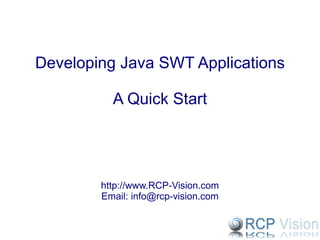Developing Java SWT Applications - A Starter
- 1. Developing Java SWT Applications A Quick Start http://www.RCP-Vision.com Email: info@rcp-vision.com
- 2. SWT Applications in minutes In this short presentation we will learn how to develop and deploy a simple SWT Application in a matter of minutes.
- 3. Requirements The setup process however is not included in these minutes, because you will have to do some download and setting process. Anyway this is a one-time task!
- 4. Requirements Ensure you have a Java JDK installed (Java 1.5 or higher)
- 5. Download Eclipse RCP distro Go to the Eclipse download page: http://www.eclipse.org/downloads and download the RCP version of Eclipse
- 6. Extracting Eclipse RCP IDE Extract the downloaded file (e.g. ŌĆ£eclipse-rcp-ganymede-SR1-win32.zipŌĆØ) somewhere on your local drive (e.g. on C:) Note: do not use the the Compressed Folder unzipper shipped with the operating system since it may not extract hidden files
- 7. Running Eclipse RCP IDE Run the Eclipse executable file (e.g. C:clipseclipse.exe)
- 8. Running Eclipse RCP IDE Choose a workspace location
- 9. Running Eclipse RCP IDE and close the Welcome page
- 10. Create a Java Project File, New, Java Project
- 11. Create a Java Project Enter a name for the Project (e.g. FirstSwtProject) and press the Next button
- 12. Create a Java Project Select the ŌĆ£LibrariesŌĆØ tab and press the ŌĆ£Add External JARs ...ŌĆØ button
- 13. Create a Java Project Browse and select the file <eclipse_dir>/plugins/ org.eclipse.swt.win32.win32.x86_3.4.1.v3449c.jar
- 14. Create a Java Project Select the ŌĆ£Order and ExportŌĆØ tab and check the jar file we just added (this will export this jar file in the deploy phase) and press the ŌĆ£FinishŌĆØ button
- 15. Create a Java Class Expand the Project tree, select the ŌĆ£srcŌĆØ folder and right-click New, Class
- 16. Create a Java Class Enter a package name for the new class (e.g. ŌĆ£com.yourcompany.swt.testŌĆØ)
- 17. Create a Java Class Enter a name for the new class (e.g. ŌĆ£MainFormŌĆØ) and make it executable (checking ŌĆ£public static void main(String[] args) then press the ŌĆ£FinishŌĆØ button
- 18. Edit the Java Class Fill the MainForm class with the following code public class MainForm { private static int n = 0; public static void main(String[] args) { Display display = new Display(); Shell shell = new Shell(display); shell.setText( "Click counter" ); shell.setBounds(100, 100, 200, 100); shell.setLayout( null ); final Label label = new Label(shell, SWT. PUSH ); label.setBounds(120, 20, 30, 30); final Button button = new Button(shell, SWT. PUSH ); button.setBounds(10, 10, 80, 30); button.setText( "Click Me" ); button.addSelectionListener( new SelectionAdapter() { public void widgetSelected(SelectionEvent event) { n ++; label.setText( "" + n ); } }); shell.open(); while (!shell.isDisposed()) { if (!display.readAndDispatch()) display.sleep(); } display.dispose(); } }
- 19. Edit the Java Class In order to solve the errors that are showed: right-click on the editor area and perform a ŌĆ£ Source, Organize importsŌĆØ operation
- 20. Edit the Java Class Choose to import the SWT Button and Label class (ŌĆ£org.eclipse.swt.widgets.ButtonŌĆØ and ŌĆ£org.eclipse.swt.widgets.LabelŌĆØ )
- 21. Run the Java Class Save the class (File, Save) then Right-click on the editor area and perform a ŌĆ£ Run as, Java ApplicationŌĆØ
- 22. Run the Java Class You should see a form with a button and a label showing the number of times the button was clicked
- 23. Deploy the Application Now that we have developed our (tiny) application how do we deploy it to a client ? First of all there is a requisite: on the client there must be a Java Runtime Environment installed
- 24. Deploy the Application Right-click on the Project, Export
- 25. Deploy the Application Expand the Java node, select ŌĆ£Runnable JAR fileŌĆØ, then press the Next button
- 26. Deploy the Application Select the (only) runnable Class
- 27. Deploy the Application Browse and enter a name for the exported JAR (e.g. C:empyFirstSWTApp.jar), then press the Finish button
- 28. Deploy the Application Ok, we are finished! Now just double-click the exported JAR file: it is your executable Java SWT Application. It can copied and launched from any client with a Java Runtime Environment installed!
















![Create a Java Class Enter a name for the new class (e.g. ŌĆ£MainFormŌĆØ) and make it executable (checking ŌĆ£public static void main(String[] args) then press the ŌĆ£FinishŌĆØ button](https://image.slidesharecdn.com/SWT_Lesson_1-090220034312-phpapp02/85/Developing-Java-SWT-Applications-A-Starter-17-320.jpg)
![Edit the Java Class Fill the MainForm class with the following code public class MainForm { private static int n = 0; public static void main(String[] args) { Display display = new Display(); Shell shell = new Shell(display); shell.setText( "Click counter" ); shell.setBounds(100, 100, 200, 100); shell.setLayout( null ); final Label label = new Label(shell, SWT. PUSH ); label.setBounds(120, 20, 30, 30); final Button button = new Button(shell, SWT. PUSH ); button.setBounds(10, 10, 80, 30); button.setText( "Click Me" ); button.addSelectionListener( new SelectionAdapter() { public void widgetSelected(SelectionEvent event) { n ++; label.setText( "" + n ); } }); shell.open(); while (!shell.isDisposed()) { if (!display.readAndDispatch()) display.sleep(); } display.dispose(); } }](https://image.slidesharecdn.com/SWT_Lesson_1-090220034312-phpapp02/85/Developing-Java-SWT-Applications-A-Starter-18-320.jpg)









